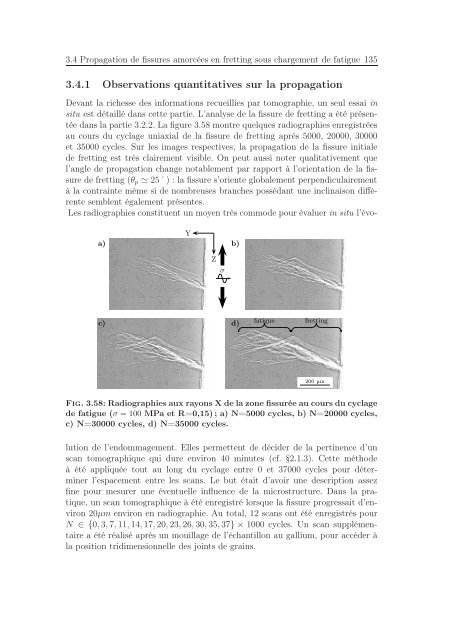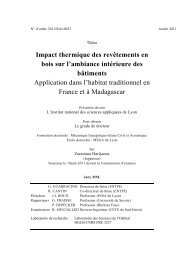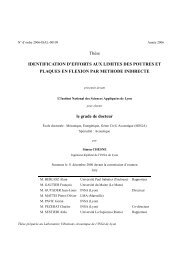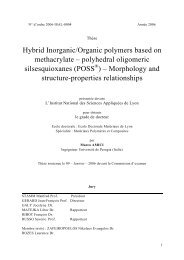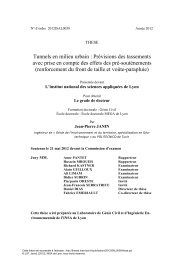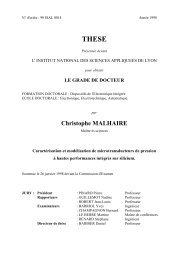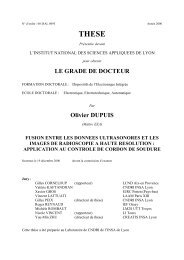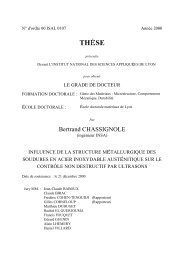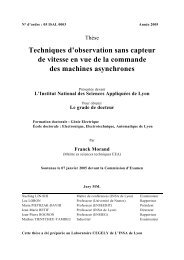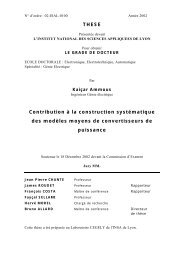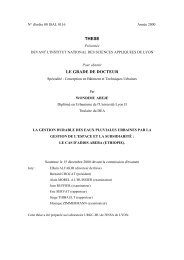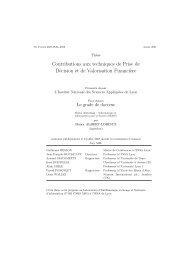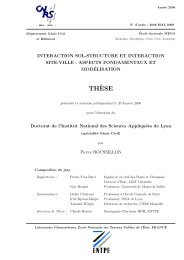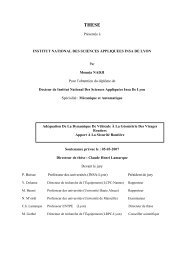Identification des mécanismes de fissuration dans un alliage d ...
Identification des mécanismes de fissuration dans un alliage d ...
Identification des mécanismes de fissuration dans un alliage d ...
You also want an ePaper? Increase the reach of your titles
YUMPU automatically turns print PDFs into web optimized ePapers that Google loves.
3.4 Propagation <strong>de</strong> fissures amorcées en fretting sous chargement <strong>de</strong> fatigue 135<br />
3.4.1 Observations quantitatives sur la propagation<br />
Devant la richesse <strong><strong>de</strong>s</strong> informations recueillies par tomographie, <strong>un</strong> seul essai in<br />
situ est détaillé <strong>dans</strong> cette partie. L’analyse <strong>de</strong> la fissure <strong>de</strong> fretting a été présentée<br />
<strong>dans</strong> la partie 3.2.2. La figure 3.58 montre quelques radiographies enregistrées<br />
au cours du cyclage <strong>un</strong>iaxial <strong>de</strong> la fissure <strong>de</strong> fretting après 5000, 20000, 30000<br />
et 35000 cycles. Sur les images respectives, la propagation <strong>de</strong> la fissure initiale<br />
<strong>de</strong> fretting est très clairement visible. On peut aussi noter qualitativement que<br />
l’angle <strong>de</strong> propagation change notablement par rapport à l’orientation <strong>de</strong> la fissure<br />
<strong>de</strong> fretting (θ p ≃ 25˚) : la fissure s’oriente globalement perpendiculairement<br />
à la contrainte même si <strong>de</strong> nombreuses branches possédant <strong>un</strong>e inclinaison différente<br />
semblent également présentes.<br />
Les radiographies constituent <strong>un</strong> moyen très commo<strong>de</strong> pour évaluer in situ l’évo-<br />
Y<br />
a) b)<br />
Z<br />
σ<br />
c) d) fatigue fretting<br />
200 µm<br />
Fig. 3.58: Radiographies aux rayons X <strong>de</strong> la zone fissurée au cours du cyclage<br />
<strong>de</strong> fatigue (σ = 100 MPa et R=0,15); a) N=5000 cycles, b) N=20000 cycles,<br />
c) N=30000 cycles, d) N=35000 cycles.<br />
lution <strong>de</strong> l’endommagement. Elles permettent <strong>de</strong> déci<strong>de</strong>r <strong>de</strong> la pertinence d’<strong>un</strong><br />
scan tomographique qui dure environ 40 minutes (cf. §2.1.3). Cette métho<strong>de</strong><br />
à été appliquée tout au long du cyclage entre 0 et 37000 cycles pour déterminer<br />
l’espacement entre les scans. Le but était d’avoir <strong>un</strong>e <strong><strong>de</strong>s</strong>cription assez<br />
fine pour mesurer <strong>un</strong>e éventuelle influence <strong>de</strong> la microstructure. Dans la pratique,<br />
<strong>un</strong> scan tomographique à été enregistré lorsque la fissure progressait d’environ<br />
20µm environ en radiographie. Au total, 12 scans ont été enregistrés pour<br />
N ∈ {0, 3, 7, 11, 14, 17, 20, 23, 26, 30, 35, 37} × 1000 cycles. Un scan supplémentaire<br />
a été réalisé après <strong>un</strong> mouillage <strong>de</strong> l’échantillon au gallium, pour accé<strong>de</strong>r à<br />
la position tridimensionnelle <strong><strong>de</strong>s</strong> joints <strong>de</strong> grains.


